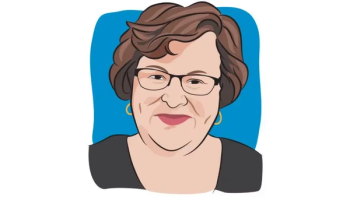
Opdivo Granted Priority Review for Post-Surgical Melanoma Treatment
Opdivo (nivolumab) was granted a priority review to a supplemental biologics license application (sBLA) to treat patients with melanoma who have a high risk of disease recurrence after complete surgical resection, according to Bristol-Myers Squibb (BMS), the company that makes the drug.
Opdivo (nivolumab) was granted a priority review to a supplemental biologics license application (sBLA) to treat patients with melanoma who have a high risk of disease recurrence after complete surgical resection, according to Bristol-Myers Squibb (BMS), the company that makes the drug.
Previously, the FDA granted a breakthrough designation for Opdivo in this setting. The priority review is based on results from the CheckMate-238 trial, in which Opdivo significantly improved relapse-free survival (RFS) versus standard Yervoy (ipilimumab) in patients with resected stage 3B/C and 4 melanoma.
“Priority review of our sBLA and the granting of breakthrough designation are positive steps forward in our goal to address the high unmet need that exists among patients with resected advanced melanoma, many of whom experience disease recurrence,” Murdo Gordon, BMS executive vice president and chief commercial officer, said in a press release.
From March 2015 to November 2015, CheckMate-238 randomized patients aged 15 years or older with stage 3B, 3C or 4 melanoma to either 3 mg/kg of Opdivo every two weeks (453 patients) or 10 mg/kg of Yervoy every three weeks for four doses, then every 12 weeks (453 patients) for one year or until documented disease progression or unacceptable toxicity. The primary endpoint was RFS, defined as the time between randomization and the date of first recurrence or death.
Randomization was stratified according to disease stage (3B or 3C, stage 4 M1a or M1b, or stage 3 M1c) and PD-L1 status (negative or intermediate vs positive) on the basis of a 5 percent cutoff.
At a minimum follow-up of 18 months, the 12-month RFS rate was 70.5 percent in the Opdivo group versus 60.8 percent in the Yervoy group.
Among the patients with PD-L1 expression less than 5 percent, the 12-month RFS rate was 64.3 percent in the Opdivo group and 53.7 percent in the Yervoy group. Among those with PD-L1 expression 5 percent or greater, the 12-month RFS rate was 81.9 percent in the Opdivo arm and 73.8 percent in the Yervoy arm.
Median RFS had not been reached in patients with stage 3 or stage 4 disease in the Opdivo group. Among the patients with stage 3B or 3C disease, the 12-month RFS rate was 72.3 percent for those assigned to Opdivo and 61.6 percent in the Yervoy group. The twelve-month RFS rate also favored Opdivo among those with stage 4 disease, at 63.0 percent versus 57.5 percent.
Opdivo was associated with significantly longer RFS, with recurrence or death reported in 32.7 percent of the Opdivo group compared with 44.5 percent in the Yervoy group among those with stage 3B or 3C disease. Among those with stage 4 disease, 33 of 82 patients (40.2 percent) in the Opdivo group experienced recurrence or death versus 43 of 87 patients (49.4 percent) in the Yervoy group.
“In addition, a benefit for nivolumab was observed with respect to recurrence-free survival in nearly every subgroup tested, including those defined according to age, sex, disease stage, microscopic versus macroscopic nodal disease, ulceration status of the primary tumor, and BRAF status,” lead CheckMate-238 author Jeffrey Weber, M.D., deputy director, Perlmutter Cancer Center, New York University Langone Medical Center, and coinvestigators wrote in the publication of the findings in the New England Journal of Medicine.
The median distant metastasis—free survival was not reached in either treatment group. However, distant metastasis–free survival was superior in patients assigned to Opdivo, with events reported in 93 of 369 patients (25.2 percent) versus 115 of 366 patients (31.4 percent) in the Yervoy group (HR for distant metastasis or death, 0.73; 95 percent CI, 0.55-0.95).
Nearly 97 percent of the Opdivo group and 98.5 percent of the Yervoy group reported adverse events (AEs) of any cause. Patients in the Yervoy were more likely to experience grade 3/4 treatment-related AEs, at 45.9 percent vs 14.4 percent. The rate of serious AEs of any grade was 17.5 percent in the Opdivo group and 40.4 percent in the Yervoy group.
Fewer than 10 percent of patients assigned to Opdivo (9.7 percent) discontinued the trial due to AEs compared with 42.6 percent of those in the Yervoy group. Grade 3/4 AEs led to such discontinuations in 4.6 percent of Opdivo patients and 30.9 percent Yervoy patients. Investigators determined that AEs related to a trial drug that led to discontinuation were less frequent in the Opdivo group than in the Yervoy group (7.7 percent vs 41.7 percent).
There were two deaths (0.4 percent) in the Yervoy group of marrow aplasia and colitis, both of which occurred more than 100 days after the last dose, and no treatment-related deaths in the Opdivo group.
The FDA approved Yervoy in October 2015 for the adjuvant treatment of patients with stage 3 melanoma with pathologic involvement of regional lymph nodes greater than 1 mm who have undergone complete resection including total lymphadenectomy.




